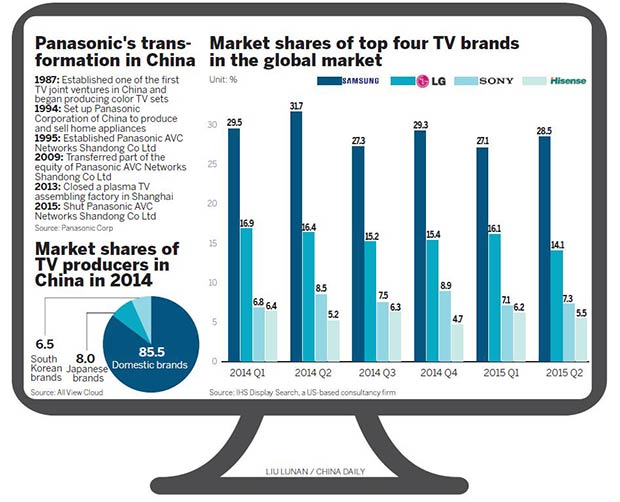
Iconic firms seek revival by foraying into a wide range of new business segments
There was a time when Chinese consumers were enamored of Japanese home appliance brands such as Sony, Panasonic, Toshiba, Sharp, Sanyo and Hitachi. Such brands dominated segments like televisions, music systems, washing machines, refrigerators, you name it. Not any more.
The rise of homegrown Chinese home appliance makers such as Haier Group, TCL Corp and Hisense Group has hurt Japanese electronics giants badly, pushing the latter into areas like high-end intelligent home appliances, business-to-business or B2B activities, construction, nuclear power, housing, automobiles, startup incubation and Internet of vehicles.
For instance, in January, Panasonic Corp closed its last television production factory in China, which was located in Jinan, capital city of Shandong province. Panasonic said it will instead outsource its TV production to Chinese contract manufacturers.
In August, it shut a factory in Beijing that produces lithium-ion batteries for laptops and smartphones, laying off about 1,300 employees.
This year, Panasonic shifted its focus to businesses related to automobiles, housing and B2B activities. To gain a quick entry and market share through acquisition of firms engaged in those areas, it set up a 1 trillion yen ($8.19 billion) fund.
"We have set a goal of 10 trillion yen in profit in 2018, with the B2B business accounting for 80 percent of the total. Further development of the B2B field is key to moving Panasonic forward. We will also be committed to B2B in China," said Hidetoshi Osawa, chairman of Panasonic China.
Besides audio-visual information and communication technology, Panasonic will provide B2B solutions for housing, environmental projects, automobiles and electrical systems, he said.
Last year, Panasonic and Tesla Motors Inc, the United States-based maker of electric cars, teamed up to build lithium-ion battery factory in the US. Panasonic is targeting to double sales of its car battery-related business to 37.5 billion yuan ($6.47 billion) in 2018 from the 2014 level.
In 2011 and 2012, the company reported losses of 772.2 billion yen and 754.3 billion yen, respectively. The loss from home appliances was 8.5 billion yen in the first quarter of 2015.
Not unexpectedly, it laid off nearly 10,000 employees in the past two years. In the first quarter of this year, its net profit was 59.5 billion yen, up just 5.7 percent year-on-year, which it attributed mainly to its car-related B2B business.
As for its core competence in home appliances, Panasonic intends to focus on the high-end segment of intelligent devices and machines in China, to cater to the growing high-income middle class families, said Masanao Yamauchi, general manager of Panasonic China Appliances Co.
Panasonic's vision is to make products that would enable consumers to control, say, electric cookers using their mobile phones.
"Our aim is to connect different smart home appliances and create intelligent indoor spaces for families, communities and towns," said Yamauchi.
Like Panasonic, Sony Corp is chasing a revival in China. Ever since Kazuo Hirai's appointment as president and CEO in 2012, the company has been restructuring itself. It sold its Vaio computer business and spun off its TV division. "Profit from the electronics business, except the mobile phones, has improved as a result of the restructuring," said Hirai.
In 2014, revenue was about $68.47 billion, up 5.8 percent year-on-year, and operating profit was $571 million. Its TV business, now with focus on high-end models, posted its first profit in 11 years.
"We will increase sales of high-end products to ensure profits. We will focus on the post-1980 and post-1990 generations and middle-class users and cultivate new businesses with unique technologies," said Nobuki Kurita, president of Sony China Co Ltd.
For Sony, the Chinese market is a priority alongside the US, he said. Sony now has three key businesses in China, including consumer electronics, specialized business solutions and devices, said Kurita.
In consumer electronics, Sony's focus is on value-added products like high-resolution, extremely slim television sets, and imaging products and solutions, including specialized broadcasting audio equipment, projectors, digital cinema and B2B business involving medical and telecommunication equipment, Kurita said.
Last year, Sony launched the Seed Acceleration Program, a startup incubator that seeks to fast-track promising new business ideas. The program has already spawned startups for smart locks, smart wristbands and smartwatches.
The Japanese exit from electronics extended beyond China. Chinese TV maker Hisense acquired Sharp's TV factory in Mexico and its television business for the North and South American markets.
Elsewhere, faced with huge losses, Toshiba Corp exited TV production and decided to focus on construction, nuclear power and infrastructure and other B2B businesses.
Japanese giants' efforts to remain relevant are a result of Chinese enterprises' newly acquired mastery in home appliance technologies and cost advantages, which hurt the former's profits, said Zhang Yanbin, assistant director of All View Cloud, a Beijing-based consultancy specializing in home appliances. The shift to other areas "is a necessity" and a "strategic adjustment", he said.
Liang Zhenpeng, an analyst of consumer electronics, said: "Japanese companies must simplify the decision-making process, improve operational efficiency and strengthen the transformation to intelligent and internet-enabled fields."
What is an 'intelligent' or smart appliance?
Smart home products are devices or appliances that can be operated, controlled and monitored using mobile phones via Internet. They use technologies like cloud computing and big data, and have the capability to be connected to other such devices.


















































